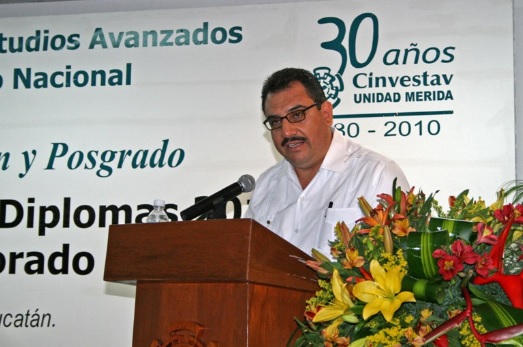When we talk about Maya heritage, one of the most important legacies in the Yucatan Peninsula is the “Azul Maya” (Maya Blue), a pigment developed widely by this civilization and used by different Mesoamerican cultures for the decoration of ceramics, textiles and murals, as explained by Romeo de Coss Gómez, researcher attached to the Center for Research and Advanced Studies (Cinvestav) in Mérida, Yucatán.
“More than 5,000 years later, its existence continues to attract the attention of world science, since it is a hybrid compound, formed by the incorporation of organic molecules in inorganic matrices, which gives it important characteristics, such as resistance to abrasion, sunlight and high temperatures, among others”, said the doctor member of the organizing committee of the recently concluded 5th Encounter Knowledge, Science and Technology in a Multicultural World.

Romeo de Coss Gómez, researcher attached to the Center for Research and Advanced Studies (Cinvestav) in Mérida, Yucatán (Photo: CINVESTAV)
“These are materials that are currently under investigation. The pores where the indigo molecule was introduced are in nanoscale, which makes us wonder, how did the Maya know they could do this? Even more impressive is the fact that the palygorskite, this white powder that exists in the Ticul municipality, features these nanoporous channels. Which makes us think, for what other purpose can we use it? And therefore, new projects and ideas are surging today, in the year 2018.” de Coss Gómez said during an interview with Agencia Informativa Conacyt.
Palygorskite or attapulgite is a magnesium aluminium phyllosilicate that occurs in a type of clay soil common to the Southeastern United States. It is one of the types of fuller’s earth. Some smaller deposits of this mineral can be found in Yucatán, Mexico, where its use is tied to the manufacture of a pigment known as Maya Blue in pre-Columbian times. (Wikipedia).
Analysis
From samples provided by the National Institute of Anthropology and History (INAH) Yucatán, the researcher has studied different aspects of Maya Blue -such as the spectrum of absorption of X-rays and the vibrational spectrum in the infrared- in order to differentiate it from other materials, like the ultramarine blue that is sometimes confused with Maya Blue.
A comparative study of ultramarine blue and Maya Blue was published in 2012 in the journal “MRS Proceedings”, by the group of researchers from INAH Yucatan and Cinvestav Mérida under the title “Comparative study of two blue pigments from the Maya region of Yucatan”.

Mayan Mural, involving the Maya Blue pigment (via Wikispaces)
Gabriel Canto Santana, attached to the Autonomous University of Campeche, has studied the chemical bond of the organic indigo molecule inside the pores of the palygorskite, which results were published in 2017 in the journal “Microporous and Mesoporous Materials” under the title “Trapping and diffusion of organic dyes inside of palygorskite clay: The ancient Maya Blue pigment”.
From the collaboration of the work groups of researchers Romeo de Coss and Gabriel Canto, a study was started on the chemical bonding of the hydrogen molecule inside the pores of the palygorskite, with the purpose of evaluating the possibility of introduce hydrogen molecules for storage.
Application
“The hypothesis we are developing is that this nanoporous clay, the palygorskite, could perhaps be used as a sponge to store hydrogen for the use of renewable energies in the future” said Dr. Romeo de Coss.
“It is something that we just started to study and investigate, first we are going to conduct a series of analysis through calculations and then we will proceed to the experimental part. But the inspiration came from having studied the Maya Blue. I think it’s the kind of discovery triggered by understanding and looking at our ancestor’s wisdom”, he continued.
The municipality of Ticul is known as the current source of palygorskite for its use in pottery. Generally the potters of this area grind the palygorskite and mix it with other clays to elaborate decorative objects.
“We must ask ourselves what can we do now? What kind of new knowledge and new technology can we generate? Review and learn from what was done in the past is important to understand the present and be able to project forward into the future. The more we learn about the technologies developed by our ancestors, the more impressed and motivated we get” concluded the researcher.
Source: yucatan.com.mx

